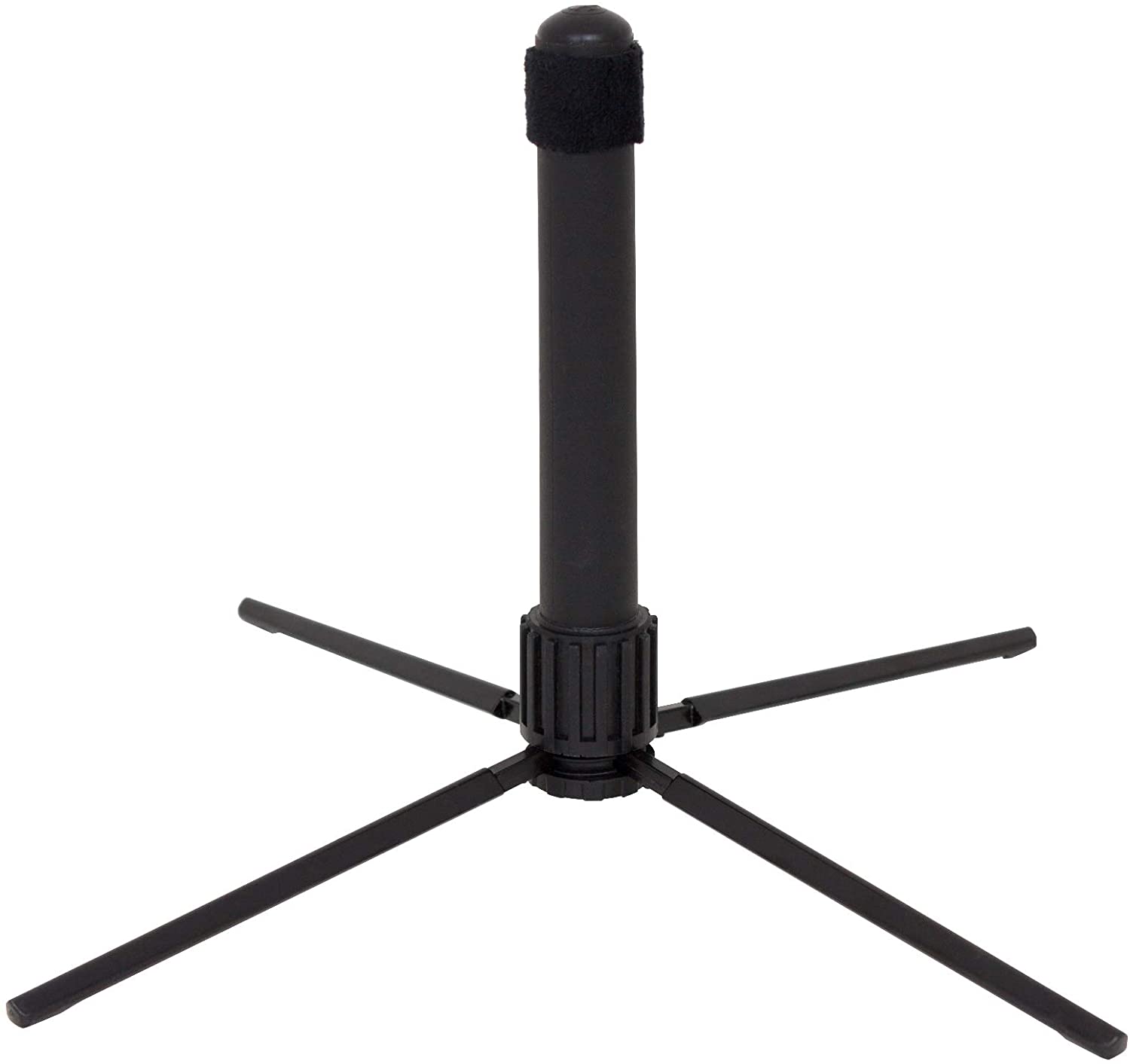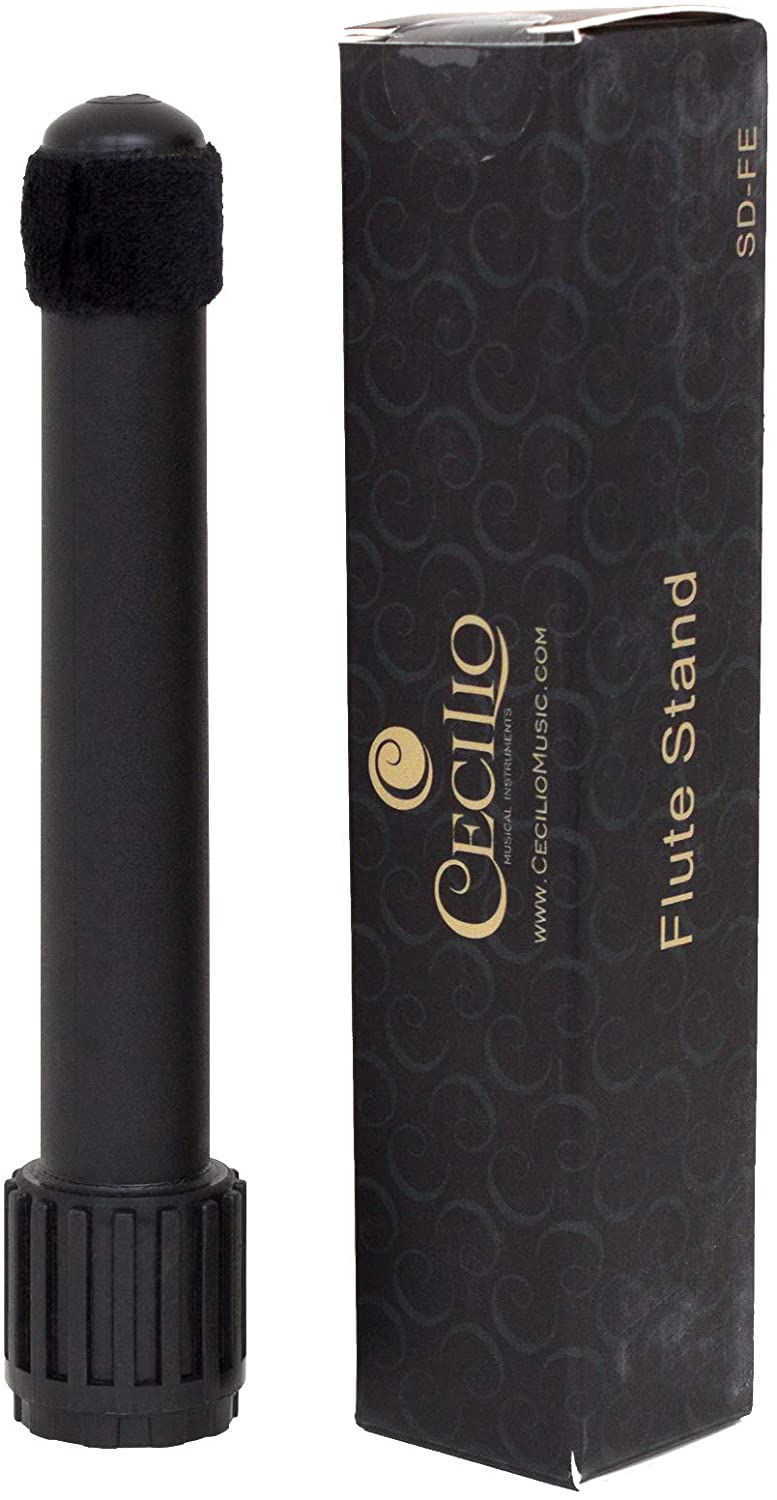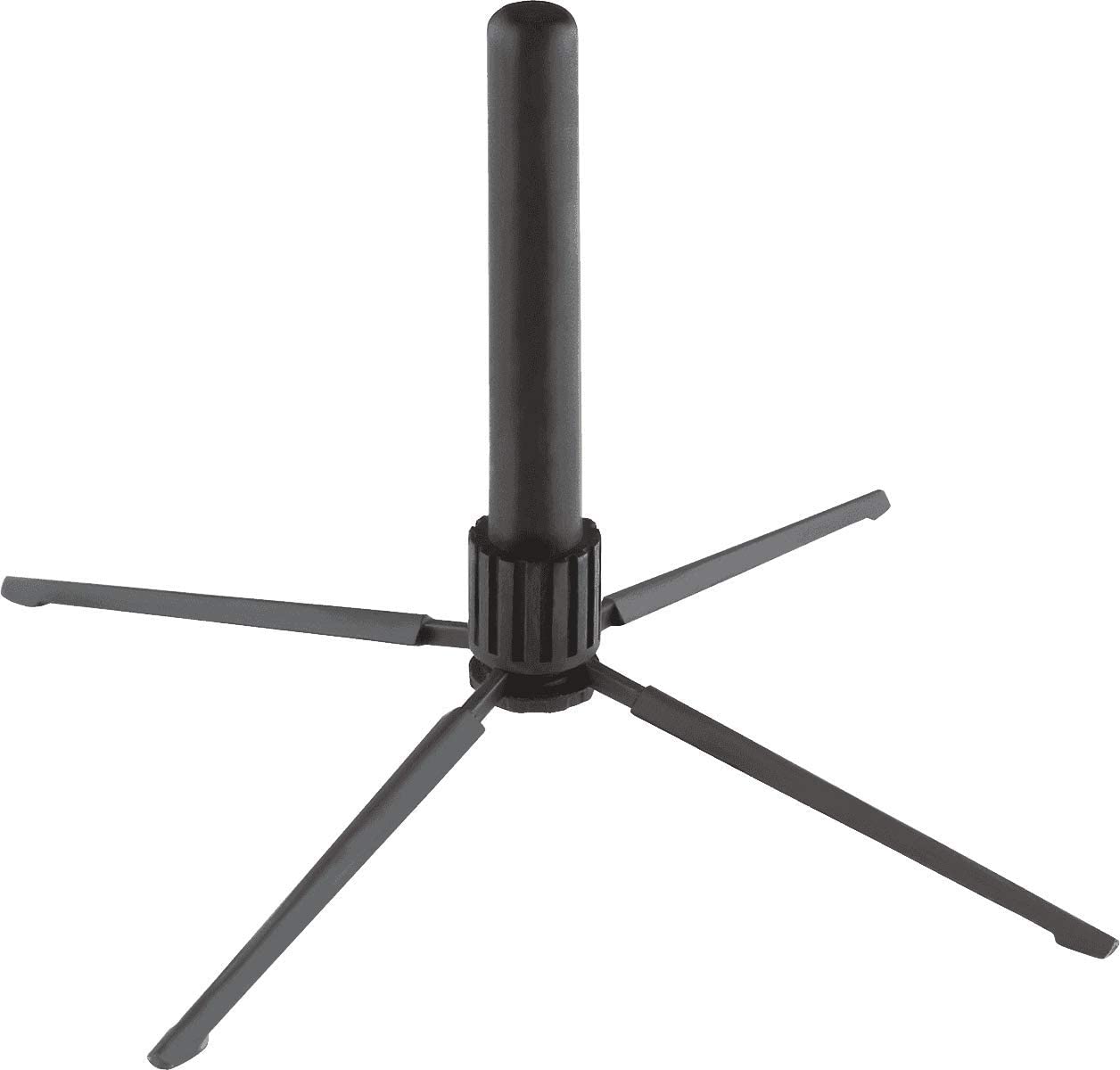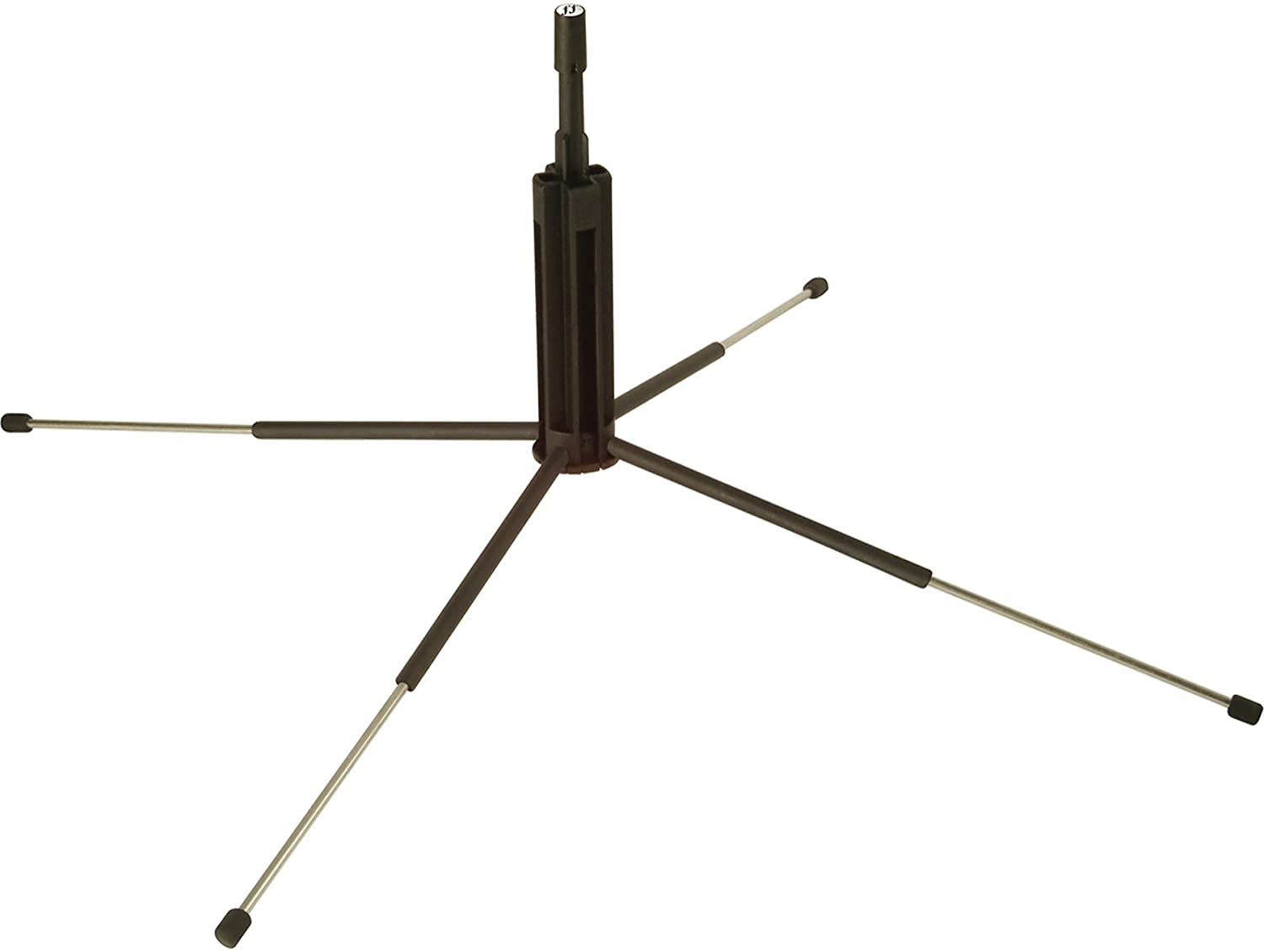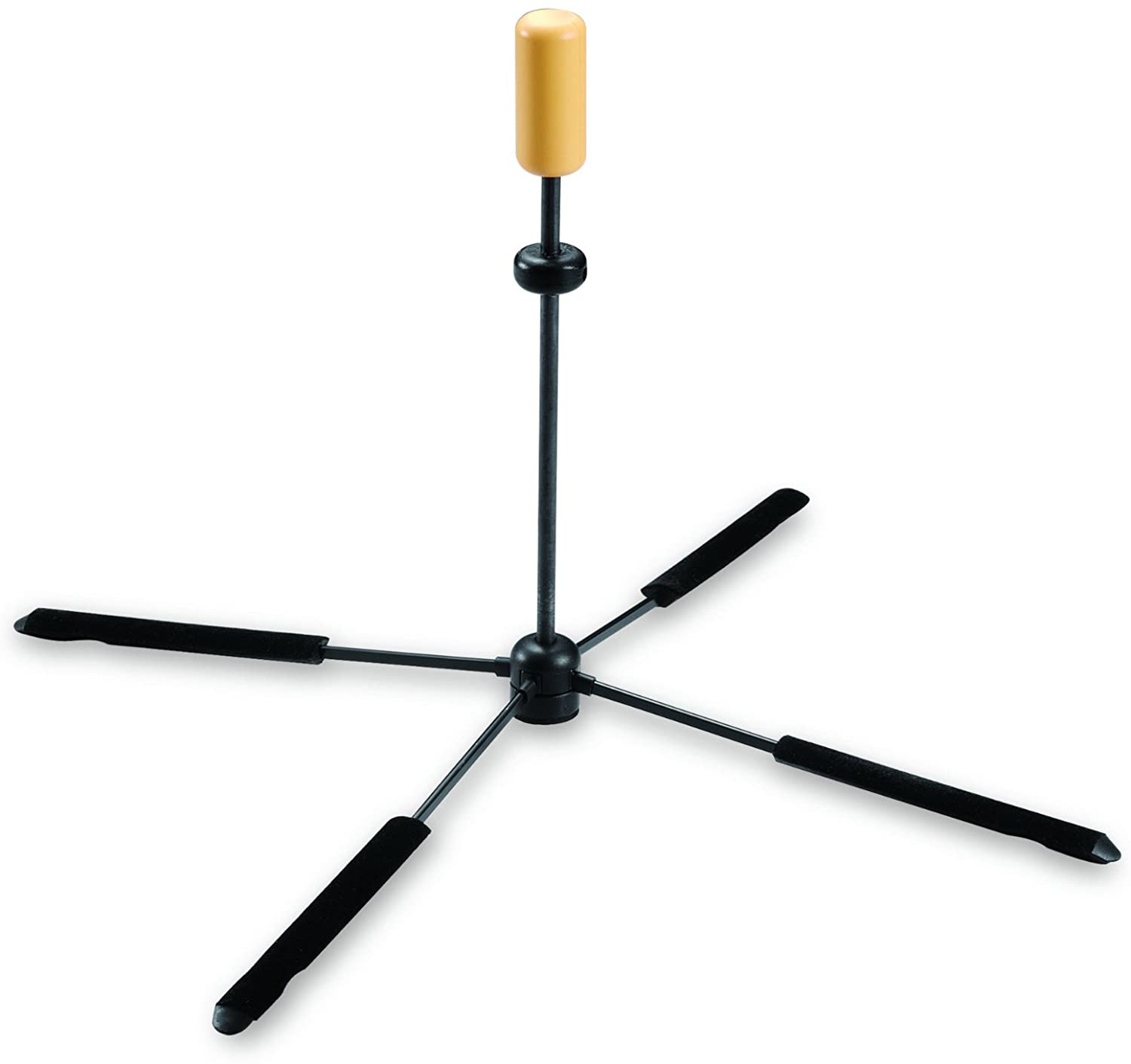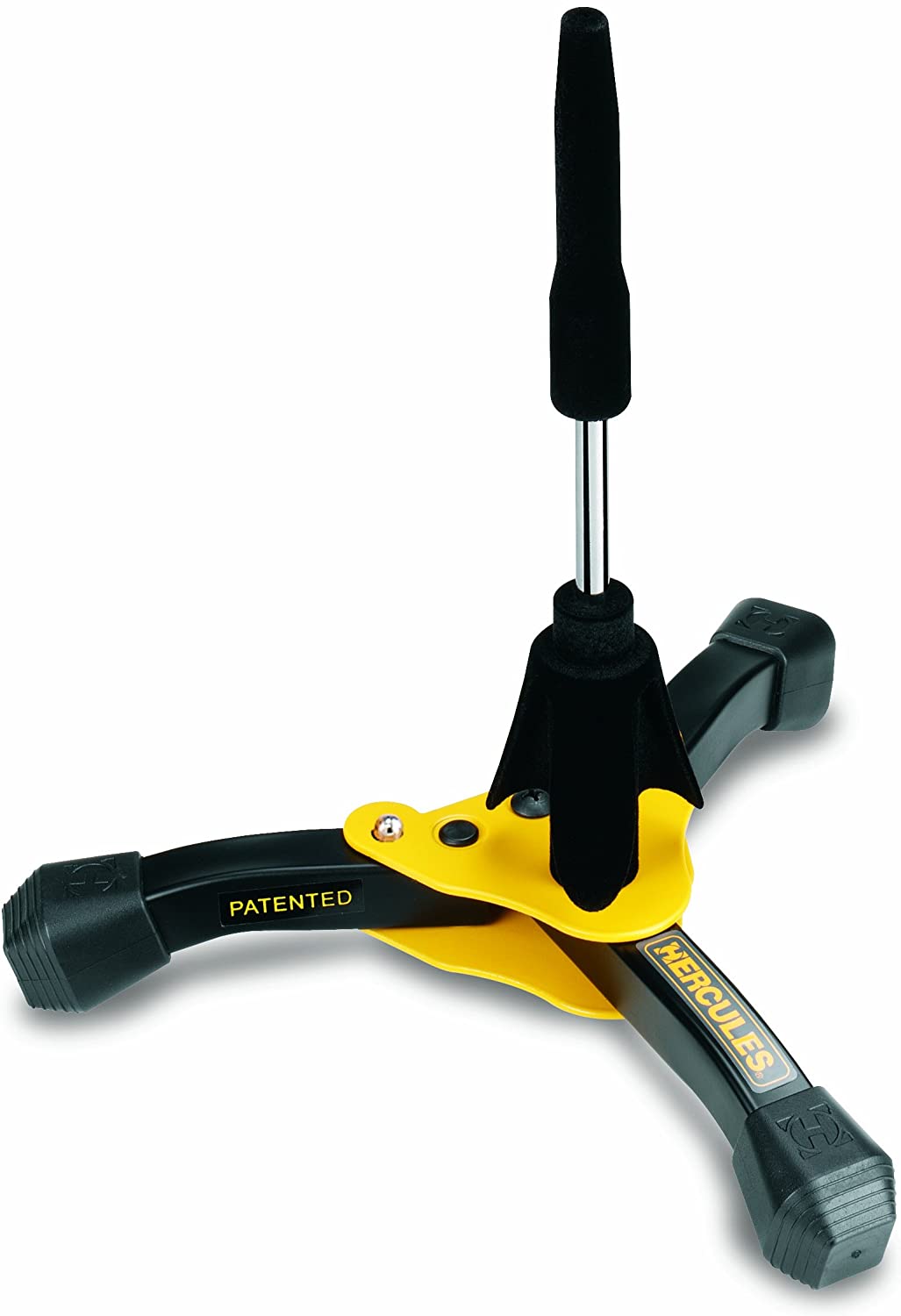- How to Find the Best Sopranino Saxophone - May 31, 2022
- How to Find the Best Contrabass Saxophone - May 30, 2022
- Trumpet Range Guide: Understanding The Entire Trumpet Range - May 19, 2022
Are you tired of haphazardly resting your flute on your chair or music stand? Consider our Cecilio Foldable Flute Stand review and guide to learn about your options for protecting your flute.
That way, you don’t have to worry about your flute rolling off and getting damaged. Instead, you can leave it for a quick break and know it will be safe while you’re gone.
What Is the Cecilio Foldable Flute Stand?
The Cecilio Foldable Flute Stand is an affordable stand you can use to support your flute when you aren’t playing. You can fold up the legs so that the stand is easy to store and transport.
It features a set of four metal legs that come out of the bottom of the stand. Meanwhile, the peg part of the stand that your flute sits on is plastic, so it won’t scratch the metal on the inside of your flute.
At the top of the stand, there’s a strip of felt to help support your flute and protect the inside. However, the strip of fabric or the design in general makes for a tight fit.
While that seems nice, it makes it hard to grab your flute off the stand quickly. The stand might come up with the flute, so you’d need a free hand to pull the stand off.
Because of that, this is a nice stand for individual practice, but it isn’t the best for use in an ensemble. But as you use the stand more, the felt may wear down enough so that the fit isn’t so tight.
When you use the Cecilio Foldable Flute Stand, you will need to unscrew the part at the bottom to help secure the legs in place. That way, the legs won’t slip out in storage or have issues when you use the stand.
It’s an excellent choice for beginners or casual players and anyone on a tight budget. However, it’s not the best choice for someone who plays a lot.
Pros
- Affordable
- Easy to set up
- Holds your flute well
Cons
- Can get stuck inside your flute
- The stand can be wobbly sometimes
How to Choose a Flute Stand
Before you rush out to get the Cecilio flute stand, you should make sure it’s the best option for you. While it might work well for some players, others may find it frustrating.
Just like finding your perfect flute, finding your ideal flute stand is crucial. That way, you’ll have an accessory you trust to keep your flute safe when you need to take a short break from playing.
Consider the following factors to help find the best flute stand for your needs.
Size
Most, if not all, flute stands have a peg with the same diameter. What I’m talking about with the size is the size of the legs and base of the stand as well as the height of the flute peg.
Some flute stands have thicker or longer legs, so they take up more room on the floor. That can add to their sturdiness, but those stands aren’t as convenient if you don’t have much room at your feet in a band or orchestra.
A taller flute peg is nice because it doesn’t take up more floor space. However, it can provide a bit of extra support to your flute, so it can be a bit harder to knock it over.
Durability
You also need to think about how durable and sturdy a flute stand is. Some of the smaller and more portable options aren’t as durable or protective of your flute.
Be sure to consider how easy the flute stand might break and if you’ll need to replace it fairly soon. Another factor is how easy it is to tip the flute stand over.
Some flute stands will stay upright when you accidentally bump your flute. However, others might fall over, which may damage your flute depending on where it lands.
Assembly
If you’re looking for a foldable or portable stand, you need to know how easy it is to put together and take apart. Some stands only take a couple of steps to assemble, while others are more complex.
The Cecilio stand is one of the easier ones since the legs sit in the body when in storage. However, you can find other stands that have a peg that you have to connect to the base.
So be sure to decide how much assembly you want to deal with. If you need a stand for practice at home, assembly won’t matter as much as if you want a stand to take with you to lessons or rehearsals.
Materials
You should also consider what materials make up the stand and if there are any special linings. For example, the Cecilio stand uses plastic and felt for the parts that touch your flute.
That’s a much better option compared to a fully metal stand. But you can also find stands with metal centers and with plastic at the top to touch your flute.
A velvet or felt lining can also be useful for protecting your flute. If you choose a metal stand, the stand may scratch the metal on the inside of your instrument, try to avoid that material.
Color
When you look at the best flute stands, you’ll find most of them are black. That’s a good color because it can help the stand blend in on a concert stage.
However, you may want to look for a stand with a bright color on the tip, such as yellow. I played in an opera pit orchestra in college, and it was so dark that I couldn’t see the black flute stand.
Fortunately, the stand I used had a yellow tip, so I could easily place my flute down. Since I had some quick swaps between the flute and piccolo, being able to see the stands I was using was super convenient.
Price
Of course, you also have to consider how much you can or want to spend on a flute stand. Some stands cost way more than others, but you don’t need the most expensive one.
Instead, make sure you know your budget so that you’ll be able to select the stand that meets that budget. However, you also want to consider the quality and value of the stand.
Saving money on a stand now may sound nice, but you could spend more in the long run if you have to replace the stand frequently. In some cases, it can be worth spending more upfront on a better stand to save money later.
Alternative Flute Stands to Try
While the Cecilio Foldable Flute Stand is an excellent option, it’s not the only flute stand you should consider. To help you select the best stand for you, I looked at some alternatives.
I made sure to find flute stands that hold up with use and that can keep your flute secure. Other factors I looked at were the cost, materials, and if there were any unique features, such as a colorful tip.
Be sure to compare the Cecilio stand to the following models before you buy your next flute stand.
K&M Flute Stand
The K&M Flute Stand is probably the most similar alternative to the Cecilio stand. It has the same basic design, with a plastic peg on top of a metal base with four legs.
You’ll need to unscrew a cap at the bottom of the stand to let the legs come out. Then, you can screw the cap back on to secure the legs for the duration of your practice session.
Unfortunately, it doesn’t have the felt lining at the top, but the plastic shouldn’t scratch your flute. I have the piccolo version of this stand, and it has held up well for multiple years.
Pros
- Basic design
- Good materials
- Easy to assemble
Cons
- No velvet or felt lining
Fortissimo Flute Stand
Another option to consider is the Fortissimo Flute Stand. It features a plastic peg where your flute will sit, so you don’t have to worry about it scratching your instrument.
The stand has four legs on the bottom, and all of them extend out to provide more support. That way, you can’t knock the stand over as easily.
Unlike other flute stands, this one has a smaller section at the top. Not only does that offer your flute more support, but it can fit your piccolo if you need to switch between the two instruments.
Pros
- Sturdy legs
- Unique design
- Easy to use
Cons
- Not the cheapest option
Hercules Travelite Flute Stand
The Hercules Travelite Flute Stand is yet another flute stand you should try. I have the older model, which is a bit shorter than the current edition, but it’s held up for around eight years.
This stand features four legs that fold out from the body, and they can extend to be longer than other stand legs. The legs have a velvet lining, so you can store the stand in your flute’s footjoint, but I wouldn’t keep it in there.
Instead, you can put it in your flute bag, and you can easily assemble the stand before you practice. Plus, the yellow tip makes it easy to find on a dark stage or in a pit orchestra.
Pros
- Lasts a long time
- Easy to set up
- Bright tip
Cons
- Not the strongest base
Hercules Flute Stand
Aside from the travel model, Hercules also has another Flute Stand. This stand is a bit bulkier than the other models, but that extra weight makes it super sturdy.
It features a massive base with three legs that fold out and stay in place with special locks. You also get a flute peg that you will screw onto the middle of the base.
That can require more room to store the stand, but the peg is taller than some flute pegs. So if you want to really lower the risk of someone knocking your flute over, you should get this stand.
Pros
- Sturdy base
- More durable than other stands
- Locks in place
Cons
- A bit bulkier than other stands
FAQs About the Cecilio Foldable Flute Stand Review and Guide
Answer: You should use a flute stand to keep your flute relatively safe when you need to set it down for a few minutes. That way, you don’t have to set it on a chair or the floor and have someone sit or step on it.
Plus, leaving your flute upright allows spit and condensation to roll out of the flute. If the condensation stays in the flute, it could get to your pads and cause keys to leak.
Answer: Most flute stands are relatively affordable, though some do cost more. Usually, the more expensive options are bigger, and some have spots for multiple instruments.
Luckily, you can find a good flute stand for not that much money. So you don’t have an excuse not get something to hold your flute.
Answer: You can use most flute stands to hold an alto flute, but it won’t be as secure as a stand for the alto. Most flute stands are too big to use with the piccolo.
However, the Fortissimo stand has a spot at the top to rest your piccolo. So consider if you want to use one stand for both instruments before you choose a stand.
Answer: I have a full collection of flute stands, but you don’t need more than one. Personally, I like having a stand to use when I practice at home and a more portable stand to use on the go.
But you really only need to have multiple stands if you want to have stands specific to the piccolo or alto flute. Otherwise, you can start with one flute stand.
Answer: If you have a stand you only use at home, you can store it in your practice area and not disassemble it. When it comes to a stand you use outside of your home, you can keep it in your music bag.
Some stands fit inside of your flute, but I’d advise against keeping them in your instrument. The stand may keep condensation from escaping, so your pads may stop working properly.
Final Note On The Cecilio Foldable Flute Stand Review And Guide
When deciding how to protect your flute, you should consider at least one Cecilio Foldable Flute Stand review and guide. Then, you can determine if the stand is the right option for you.
If it’s not, I’d suggest trying the stands from Hercules, K&M, or Fortissimo. All of those stands can support your instrument, so it may just come down to personal preference.
Looking for more interesting readings? Check out:
- Best Flutes on Amazon Guide
- How to Find the Best C Flute: Our Top Picks!
- How to Find the Best Flute Stand [2022]


